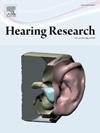Resting-state networks in chronic tinnitus: Increased connectivity between thalamus and visual areas
IF 2.5
2区 医学
Q1 AUDIOLOGY & SPEECH-LANGUAGE PATHOLOGY
引用次数: 0
Abstract
Tinnitus is thought to be associated with aberrant spontaneous activity in the central nervous system. Previous resting-state fMRI findings support this hypothesis and have shown a variety of alterations in neural activity in people with tinnitus compared to people without tinnitus. However, there is little replication of findings. Therefore, the current study aimed to extend on previous findings by investigating eight common resting-state networks (i.e. auditory, default mode, sensorimotor, visual, salience, dorsal attention, frontoparietal and language networks) using a control group (n = 36) and a group of tinnitus patients (n = 46) matched for age, sex and years of education. Hearing profiles matched up to 2 kHz and had a small but significant difference between groups in the high frequency range. Functional connectivity (FC) with dorsolateral prefrontal cortex (DLPFC) was also investigated separately for the first time, as this region is proposed to be core to tinnitus distress symptoms and most often used as a stimulation target in transcranial direct current stimulation (tDCS) research. The results showed that tinnitus patients had increased FC between bilateral thalamus and right visual association cortex compared to control participants. No differences were found with DLPFC, or with any of the resting-state networks (RSN), contrary to previous studies which have reported alterations in several RSNs.
慢性耳鸣的静息态网络:丘脑与视觉区域之间的连接性增强
耳鸣被认为与中枢神经系统的异常自发活动有关。之前的静息态 fMRI 研究结果支持这一假设,并显示与无耳鸣的人相比,耳鸣患者的神经活动发生了各种改变。然而,这些研究结果很少被重复。因此,本研究旨在扩展之前的研究结果,利用一组对照组(n = 36)和一组耳鸣患者(n = 46)(年龄、性别和受教育年限相匹配)调查八个常见的静息态网络(即听觉、默认模式、感觉运动、视觉、显著性、背侧注意、额顶叶和语言网络)。听力曲线的匹配频率高达 2 kHz,在高频范围内各组之间存在微小但显著的差异。该研究还首次单独调查了与背外侧前额叶皮层(DLPFC)的功能连接(FC),因为该区域被认为是耳鸣困扰症状的核心区域,也是经颅直流电刺激(tDCS)研究中最常用的刺激目标。结果显示,与对照组参与者相比,耳鸣患者双侧丘脑和右侧视觉联想皮层之间的FC增加了。与以往研究报告的几种静息状态网络(RSN)的改变相反,在DLPFC或任何静息状态网络(RSN)之间没有发现差异。
本文章由计算机程序翻译,如有差异,请以英文原文为准。
求助全文
约1分钟内获得全文
求助全文
来源期刊

Hearing Research
医学-耳鼻喉科学
CiteScore
5.30
自引率
14.30%
发文量
163
审稿时长
75 days
期刊介绍:
The aim of the journal is to provide a forum for papers concerned with basic peripheral and central auditory mechanisms. Emphasis is on experimental and clinical studies, but theoretical and methodological papers will also be considered. The journal publishes original research papers, review and mini- review articles, rapid communications, method/protocol and perspective articles.
Papers submitted should deal with auditory anatomy, physiology, psychophysics, imaging, modeling and behavioural studies in animals and humans, as well as hearing aids and cochlear implants. Papers dealing with the vestibular system are also considered for publication. Papers on comparative aspects of hearing and on effects of drugs and environmental contaminants on hearing function will also be considered. Clinical papers will be accepted when they contribute to the understanding of normal and pathological hearing functions.
 求助内容:
求助内容: 应助结果提醒方式:
应助结果提醒方式:


